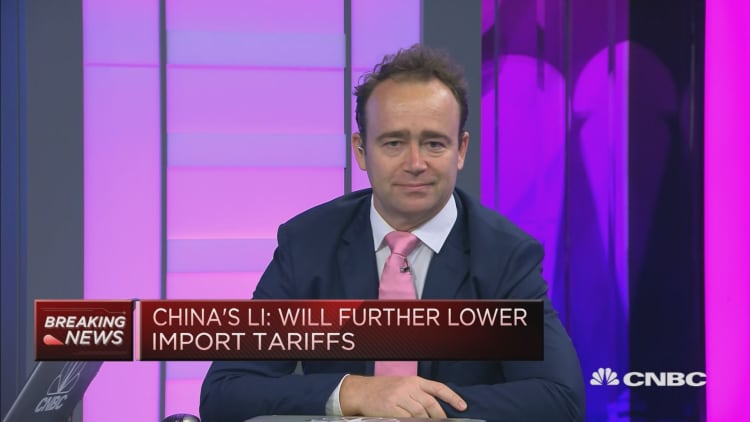
Professional investors see global growth prospects at their lowest level since Brexit as fears of a trade war surge, according to the latest Bank of America Merrill Lynch Fund Manager Survey.
On a broad level, the monthly gauge shows waning confidence in the bull market even as money continues to flow into stocks. Low-volatility bets that had reflected the market's benign nature have faded from popularity after detonating in early February, while more investors move to defensive positions, including a rush to banks.
"Cracks in the bull case are starting to emerge, with fund managers citing concerns over trade, stagflation and leverage," Michael Hartnett, chief investment strategist at BofAML, said in a statement. "Investors have yet to act on these fears, however, as rates and earnings are keeping the bulls bullish."
Indeed, the market has managed to steady itself after an initial inflation scare sent major averages into correction territory. The is up about 5 percent since bottoming Feb. 8 but overall had gained just 1.5 percent for the year heading into Tuesday trading.
Funds have continued to attract investor money, to the tune of $151.7 billion this year, according to BofAML data through March 14. Cash levels among fund managers edged lower in March from 4.7 percent to 4.6 percent.
But worries are beginning to crop up.
The correction featured the implosion of several ETFs that bet against market volatility, and that
"short-vol" theme went from being regarded as the most crowded trade in January to sixth on the list in March.
The "FAANG+BAT" trade is considered the most crowded. The trade refers to Facebook, Apple, Amazon, Netflix and Google-parent Alphabet, along with Chinese internet stocks Baidu, Alibaba and Tencent. Betting against the U.S. dollar is second on the most-crowded list.
Meanwhile, 74 percent of survey respondents see the global economy in the "late cycle," which is the most in the history of the survey.
Fears of a trade war, dormant since the early days of the Trump administration, have re-emerged since the president slapped tariffs on imported steel and aluminum earlier this month. The threat of a wider conflict topped the list of fears with 30 percent of respondents, while inflation was next at 23 percent followed by global growth at 16 percent.
It's the first time trade concerns topped the list since January 2017.
Those results mirror the most recent CNBC Fed Survey, in which trade also topped concerns, though 48 percent of respondents said they generally approve of how President Donald Trump is handling the economy.
In the BofAML survey, 87 percent of fund managers said protectionism would boost inflation and stagflation, the latter a term for sluggish growth with higher prices.
On the bright side, investors are optimistic about corporate profits, with 58 percent expecting global earnings per share to rise by more than 10 percent in the next 12 months. S&P 500 earnings are projected to jump 17 percent in the second quarter, according to FactSet.
Fund managers also are a little less afraid of rising bond yields. Survey respondents indicated a 3.6 percent yield on the benchmark 10-year Treasury note would trigger a move from stocks into bonds. A number of bond market veterans, led by DoubleLine's Jeffrey Gundlach, have put the danger zone closer to 3 percent.
WATCH: The history of trade wars is not pretty.



